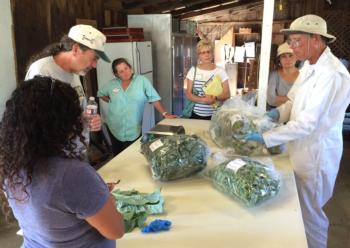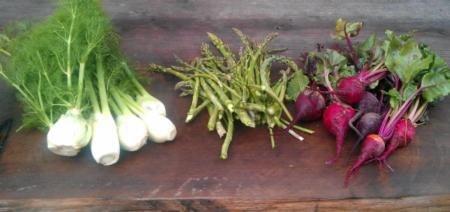Food Safety Tips to Bring Home to Your Farm or Garden
By Julia Van Soelen Kim, North Bay Food Systems Advisor

As consumers, it is important to understand the challenges our local farmers are facing and support them in their endeavors to do business even better. Although our local farmers grow exceptionally good food, most need to re-think some of their longstanding systems, spend more time keeping records, and even invest in new equipment to up their game. Annabelle Lenderink, manager of Star Route Farms, an organic produce operation in Bolinas as well as-owner of her own operation called La Tercera explained, “FSMA is adding a whole new job to our work. We have to create schedules and records for all of our routine cleaning procedures, and we have to do a lot more paperwork. But now that I know more about the law, it feels really good to know that it’s doable.” Annabelle explained that since she attended a UC Cooperative Extension Food Safety Training Series in June, she has been tweaking some operations on her farms, spending more time training workers on best practices, and is pleased that “now I understand” where and how to make changes to comply with the new law.
Other farmers I spoke with stressed that it’s okay for consumers to ask questions about how FSMA and other farming regulations might affect their operations. While they might not know the specific impacts just yet, they appreciate having informed, concerned, and committed shoppers.

While very unlikely, the risk of food borne illness is real. According to the Food and Drug Administration (FDA), produce-related food safety outbreak surveillance data from 1996-2014 recorded 173 separate outbreaks with 17,226 associated illnesses and 68 deaths. In short, food safety can be a critical concern. Many people mistakenly believe that food purchased from small family farmers or grown in gardens is inherently safer. However, food safety is relevant to everyone who grows and prepares food—whether at a commercial farm or at home, school, or community garden. That is why it’s important that we all take this opportunity to assess areas of potential risk and add to our toolbox of skills to ensure the food we eat is grown, harvested, and prepared with care.
There are some basic categories of things to think about when identifying potential food safety risks. Common routes of contamination include:
- People – the health and hygiene of those who grow, harvest, and prepare food since pathogens may be transmitted from workers to our food.
- Equipment – the equipment, tools, buildings, and sanitation systems that are used for growing, harvesting, holding, transporting, and preparing our food must be clean and well maintained.
- Water – the water used to water crops and wash harvested produce must be clean and minimize transmission of pathogens from one surface to another.
- Soil – especially manure and other biological soil amendments of animal origin must be properly handled and applied with appropriate waiting periods before harvest.
- Animals – both domesticated and wild animals can shed pathogens or transmit them from one location to another through their droppings and movements.
With these categories in mind, we can all walk through our growing processes from soil and bed preparation, to planting, to watering, to harvest, in order to identify practices that could use some modification. With a bit of practice, using good food safety habits can become second nature.



